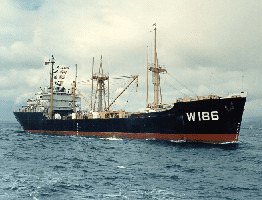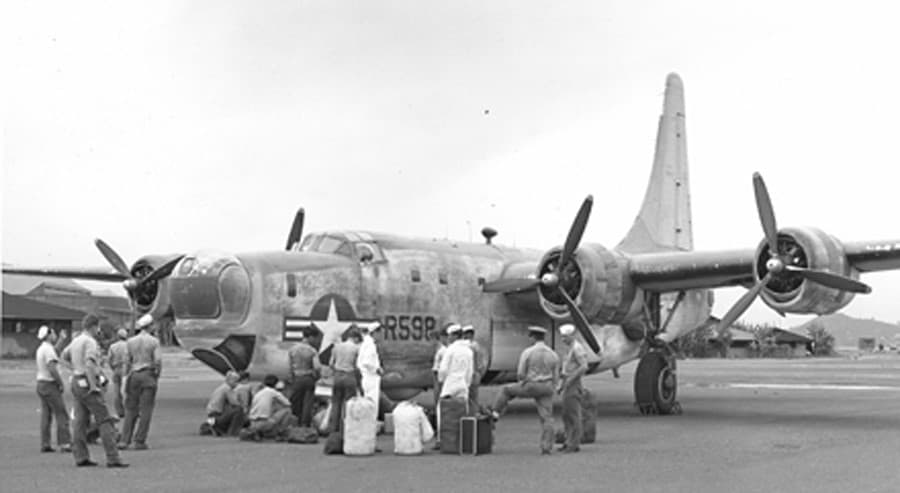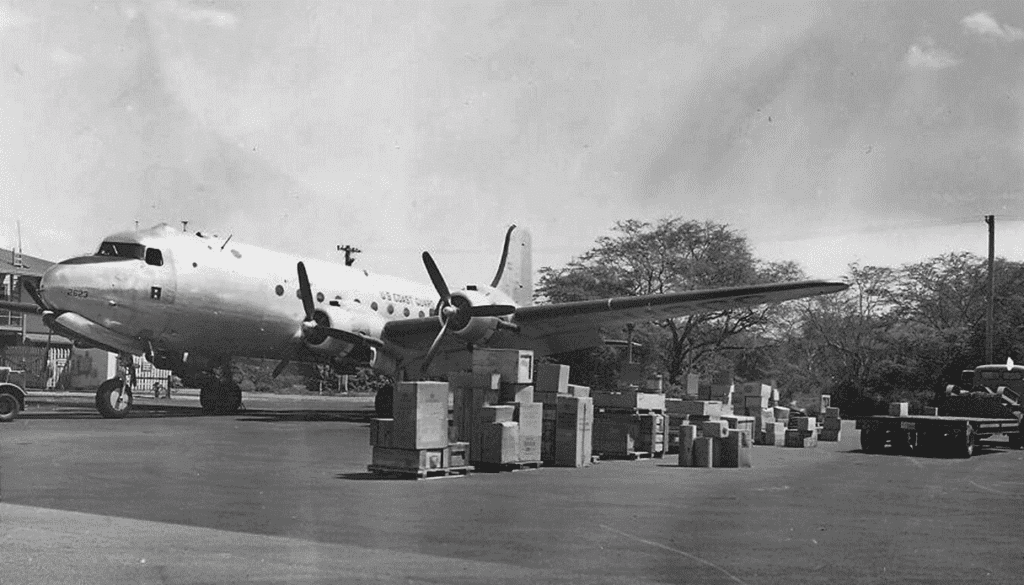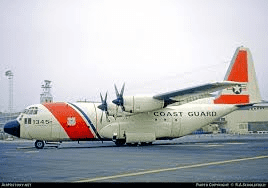A Coast Guard Aviation Story
Introduction

LORAN (LOng RAnge Navigation) was a terrestrial navigation system using ground-based transmitters. Hyperbolic LORAN lines of position (LOP) were formed by measuring the difference in reception times of synchronized signals. A LORAN net, or chain, required a master station, initiating the pulse, and a series of slave stations. In very simplified terms, the master transmits and the slave responds. Charted values of the time delay measurement were placed upon a navigational chart. The measurement observed placed one somewhere along a LOP.
That information is of little value without a LOP from a second pair. The point of intersection of the two LOPs is the location of the ship or aircraft receiving the signals.
The initial LORAN system was known as LORAN A. This ‘Top Secret” project was developed during World War II in response to the need of military ships and aircraft for a precise navigational system. The importance of LORAN to the war effort cannot be overstated. The extent of problems overcome in establishing the individual stations was exceeded only by the magnitude of the task in general. The stations which were erected provided LORAN service for practically the entire Pacific area in which combat operations were performed.
In the post war period LORAN became the primary electronic navigation system for both ships and aircraft. The Coast Guard was given the responsibility of maintaining and operating the vast majority of all LORAN stations. The LORAN chains in the Pacific were realigned and modified to support post war military and commercial requirements. Whenever and wherever support could be obtained from local sources and/or other military installations it was utilized. A large number of the stations, however, were constructed on isolated islands or other remote locations.
 A large vessel to supply equipment and personnel was needed for construction and logistical support of the Pacific LORAN chains. The USS Colquit, (AK-174) was obtained and converted to Coast Guard requirements. The name was changed to the USCGC Kukui, (WAK186)-The Kukui carried two LCMs on her decks to ferry men and equipment to shore and also had three bulldozers, several trucks and a few jeeps stashed in her holds. Seven months a year she was underway providing necessary logistic support to members of the Coast Guard LORAN chain throughout the western Pacific. During this time, Kukui delivered “everything from toothpicks to antenna poles; from a can of pepper to a “Quonset Hut.” She also carried the complex electronic equipment necessary to set up the LORAN system. The Officers and men not only sailed the ship but they operated bulldozers, landing craft, trucks and jeeps.” However, because of time and distances the frequency of support for any given Coast Guard unit was not sufficient to provide the support needed. Recognizing this Coast Guard Aviation became an integral part of the LORAN support system.
A large vessel to supply equipment and personnel was needed for construction and logistical support of the Pacific LORAN chains. The USS Colquit, (AK-174) was obtained and converted to Coast Guard requirements. The name was changed to the USCGC Kukui, (WAK186)-The Kukui carried two LCMs on her decks to ferry men and equipment to shore and also had three bulldozers, several trucks and a few jeeps stashed in her holds. Seven months a year she was underway providing necessary logistic support to members of the Coast Guard LORAN chain throughout the western Pacific. During this time, Kukui delivered “everything from toothpicks to antenna poles; from a can of pepper to a “Quonset Hut.” She also carried the complex electronic equipment necessary to set up the LORAN system. The Officers and men not only sailed the ship but they operated bulldozers, landing craft, trucks and jeeps.” However, because of time and distances the frequency of support for any given Coast Guard unit was not sufficient to provide the support needed. Recognizing this Coast Guard Aviation became an integral part of the LORAN support system.
Coast Guard Air:
Coast Guard Aviation first arrived in the Hawaiian archipelago in 1945 when Lieutenant G.W.Girdler received command of eighteen enlisted men and five officers at what was then Naval Air Station Kaneohe. Aviation assets consisted of two consolidated PBY-5 “Catalina’s” and one Grumman JRF “Goose.” The mission was search and rescue.
The JRF was retained after WWII. The PBY proved to be inadequate for the LORAN support mission and was replaced by two PB4Y-2 Privateers. With the War over the number of excess aircraft ran very high. There was a Navy Aircraft Storage Facility at Hawaii and with power of a pen at the local operating level, the Coast Guard Air Detachment acquired two PB4y2 aircraft in good condition.
The PB4Y-2s were used for Pacific supply runs. The runs went from Kaneohe to the MATS terminal at Hickam Field, then Johnson Island, Majuro, Kwajalein, Guam, Sangley Point to Japan and then back through Wake, and Midway. The trip took between 20 and 28 days and the route varied. The detachment transported everything that ATC or MATS would not carry and went to places they did not go.

Chief AOC Arnie Adams, who was based at Kaneohe at the time, provided the following information. The nose was used for baggage, the forward bomb bay for fuel tanks, the aft Bombay was decked to carry large Loran gear. The photo shows passengers and crew that were on a flight. Arnie said “CPO Joe Accamo with back to camera, with chief’s hat on, is standing with one foot on a suitcase. He was superb as a plane captain. There wasn’t too much need for a Chief Aviation Ordnanceman in 1946 so I served as the Flight Coordinator making sure the vitals and details were taken care of and do the liaison with various military outfits and Air Stations.”
In 1949 the Navy decommissioned the Kaneohe Air Station The Coast Guard Air Detachment moved to NAS Barbers Point on the west coast of Oahu and was established as a Coast Guard Air Facility. During 1949 the Air Facility received two PB-1Gs and in 1950 two R5Ds replaced the PB4Y-2s. The R5Ds were both excellent search aircraft and much better suited for the support of the LORAN stations as well as other Coast Guard units. The aviation support of Coast Guard facilities throughout the western Pacific Ocean, conducted by the Coast Guard Aviation Detachment at Barbers Point NAS, during the next decade plus, was known as “Cosmic Overseas Airways.” There are numerous stories as to how the name came about. Some were more credible than others. The most plausible given to me was that the official name of the unit was – The United States Coast Guard Western Pacific Logistic Support Air Group. Now anyone familiar with Coast Guard Aircrews knows that this was too good an opportunity to pass up. It was 1950. The Space Patrol was on TV and Flash Gordon had arrived. Cosmos was Space and anything that was gigantic or huge became “cosmic” in the language of the day. Twenty plus locations were serviced by the Coast Guard Air Detachment, Barbers Point, once or many times, in a huge area west and southwest of Hawaii. The area served was ‘Cosmic” and Cosmic Overseas Airways was born.


The first C-130’s arrived. in 1959 and the supply mission became “WestPac”. A much more efficient operation with a much more capable aircraft. No more flying over the endless ocean at an altitude of 10,000 feet with an airspeed of 170 knots. No more sound of the reciprocating engines that really didn’t leak – they just marked their territory. Cosmic Air was no longer but it did not die amongst those that flew it and knew it. A get together was held in Reno Nevada each year. The last get-together was held in 2012.
John “Bear’ Moseley
CGAA Historian


